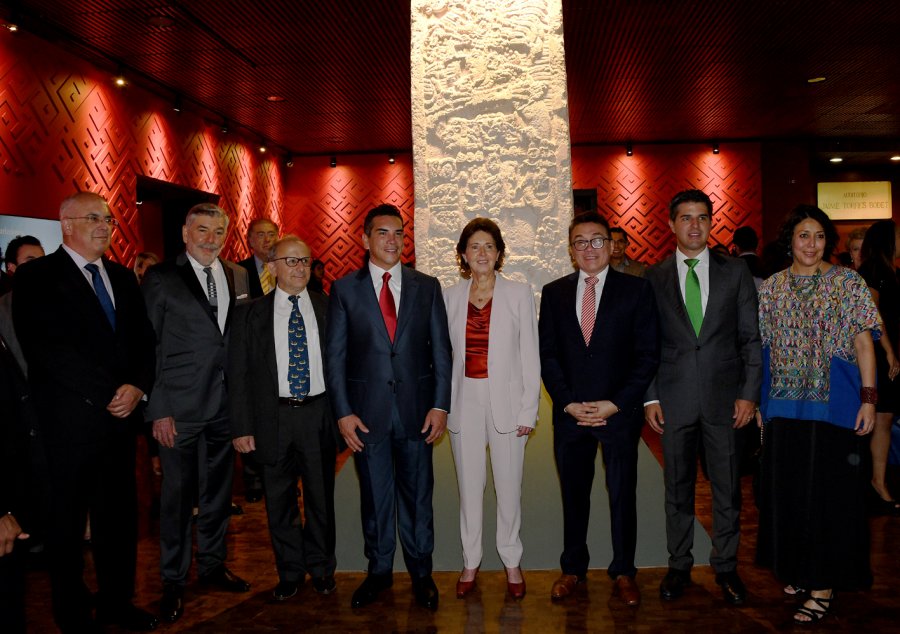Noticias
Made up of 333 pieces
Opening exhibition: Mayas, the language of beauty at the National Museum of Anthropology
August 04, 2017Symbolisms around the body, nature, earth cycles and deities that govern the various levels of the cosmos are presented, through 333 pieces that make up the great exhibition Mayas, the language of beauty, starting August 3rd at the National Museum of Anthropology.
Secretary of Culture, María Cristina García Cepeda led the opening exhibition, accompanied by Alejandro Moreno Cárdenas, governor of Campeche; Diego Prieto, director of INAH; José Enrique Ortiz Lanz, coordinator of Museums and Exhibitions of INAH and Antonio Saborit, director of the National Museum of Anthropology.
Maria Cristina García Cepeda said that this exhibition, which has been traveling in China, Germany and Italy, is an example of the civilizing wonder of a rich, mysterious and advanced culture whose legacy can be appreciated by visitors.
She reminded Miguel León Portilla who said that in our native cultures there are different faces of the time, so she acknowledged that this exhibition presents pieces from our heritage never showcased before through the Program of Artistic and Archaeological Exhibitions, an initiative that endorses the commitment of the Government of the Republic, headed by President Enrique Peña Nieto, to show Mexico’s cultural richness worldwide and bring the public closer to the legacy of the civilizations that comprise it.
She added that this exhibition carried out by INAH anthropologists, historians and archaeologists invites us to enter this enigmatic vision of the Mayan world, to the richness of a native culture at the heart of our identity, remaining alive and in constant creation.
"They are collections from five states where Mayan culture has been present and through fascinating pieces will allow to transport us to a millenarian time placing our culture in the center of Mexico’s relationship with the world”.
Alejandro Moreno Cárdenas said that these 500 years of the encounter of two worlds is an opportunity to know more about our roots and origins that have worked our identity through the centuries.
Diego Prieto said that this exhibition returns to Mexico with an enriched proposal with pieces that have not been presented and new looks on what beauty means and its influence about the development of Anthropology.
He said that sexuality, the esthetic and the reflection and construction of these elements in the ancient peoples is one of the main ideas of this exhibition, the same that deals with the corporeity of the deities and the meanings of that same element: the body .
"The bodies resemble and distinguish us, that’s why the Maya universe is complex because it shows below the underworld and at the same time tells it’s the place where the seeds are born. Its dual deities show us contrasting sides. This exhibition is without doubt one of the most originals that have been organized about ancient Mexico”, added Diego Prieto
During the opening tour the public was able to see pieces such as the sculpture of the Señor de Kabah, from the late classic (600-900 A.D.) that decorated the eastern facade of the building Codz Pop of Kabah showing a mask of the Chaahk deity.
It will also be possible to see the monument called Derrota perpetuada (perpetuated defeat), which portrays a passage in Toniná, Chiapas, where a Aj Khuhu’n or high dignitary was taken prisioner after a battle.
Another unique piece is the personification of Quetzalcoatl in the Mayan world, called Kukulcan, which is reflected in a piece found in Mayapan, Yucatan belonging to the late Postclassic (1250-1527 A.D.). In addition, it stands out the sculpture El escribano de los dioses (The scribe of the Gods), also found in that region which shows a howler man-monkey who holds a brush in the right arm, adorned with a serpent and in the other a snail shape inkwell.
The public will also be able to find the piece, La señora Ix Baah Pak', from Edzná, Campeche, a city that between 649 and 672 A.D. was ruled by a woman who is richly dressed and adorned by a hummingbird sipping a flower.
The exhibition also includes a lunar record in stone used for the Ball Game and found in Tenam Rosario, Chiapas, where the goddess Ixchel appears embracing a rabbit, an animal that represented the moon for the Mayas. The inscription on the stone accurately records the 5th day etz'nab on the penultimate day of the moon.
The exhibition Mayas, the language of beauty, is presented until November at the National Museum of Anthropology.
Mexico,Distrito Federal
